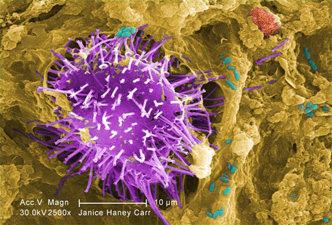What are pathogens?
Microorganisms that cause diseases are called pathogens. They are specialised to infect body tissues where they reproduce and cause damage that gives rise to the symptoms of the infection. The body fights back by mobilising its immune system to fight off the infection. Modern medicine has also developed many successful treatments to assist the body's natural defences.
Contents
How to use this site
There are a number of interactive features in this e-source:
- A glossary of terms: any word with a glossary entry is highlighted like this.
- Quick questions: at the end of a page/section, there is a set of quick questions to test your understanding of the scientific ideas.
- Roll over diagrams: many of the diagrams have highlights or sequences. You can see these by rolling your cursor over part of the picture or part of the text.
Antibiotic
Medicine that acts against
bacterial infections. Penicillin is an example of an
antibiotic.
Antibody
Protein that is produced by
lymphocytes (white blood cells) and that attaches to a
specific antigen.
Antigen
Molecule on the surface of a
pathogen that identifies it as a foreign invader to the
immune system.
Bacteria
Single-celled organism. Has a cell
wall, cell membrane, cytoplasm. Its DNA is loosely-coiled in
the cytoplasm and there is no distinct nucleus.
Biotechnology
The use of biological organisms or
enzymes to create, break down or transform a material
Dissect
To cut apart, or separate, tissue
especially for anatomical study.
Exponential growth
If something is growing
exponentially the larger the quantity gets, the faster it
grows
Fungus
Micro-organism that can grow in
long tubes called hyphae or as single cells. Fungi have a
nucleus, cytoplasm and a cell wall.
Herd immunity
If a high percentage of a
population is immune to a disease the disease cannot be
passed on because it cannot find new hosts.
HIV/AIDS
Infection caused by the human
immunodeficiency virus (HIV). It attacks and destroys the
immune system.
Hybridoma
Hybridoma cells are formed by
fusing a specific antibody-producing cell with a type of
cancer cell that grows well in tissue culture
Immune system
The body's natural defence
mechanism against infectious diseases.
Immunisation
A process which gives immune
resistance to a particular disease. The human or animal is
exposed to a harmless antigen in order to raise antibodies
and provide an immune memory.
Lymphocyte
A type of white blood cell that
make antibodies to fight off infections.
Macrophage
A type of white blood cell that
consumes dead pathogens that have been killed by
antibodies.
Parasite
Organism that feeds off another
living host and causes it some damage. An example of a
parasite is a tapeworm that lives in the digestive system of
a host organism.
Pathogen
A micro-organism that causes
disease.
Phagocyte
Phagocytes are the white blood
cells that protect the body by ingesting harmful foreign
particles, bacteria, and dead or dying cells.
Protein
A polymer made up of amino acids
joined by peptide bonds. The amino acids present and the
order in which they occur vary from one protein to
another.
Protozoa
Protozoa are one-celled
animals
Spore
A spore is a reproductive
structure that is adapted for dispersal and surviving for
extended periods of time in unfavourable conditions.
Toxin
A poisonous or toxic substance -
produced by pathogens.
Vaccination
A small amount of dead or weakened
pathogen is introduced into the body. It prepares the immune
system to prevent future infections with the live
pathogen.
Vaccine
Medicine that contains a dead or
weakened pathogen. It stimulates the immune system so that
the vaccinated person has an immunity against that particular
disease.
Virus
The smallest of living organisms.
Viruses are made up of a ball of protein that contains a
small amount of the virus DNA. They can only reproduce after
they have infected a host cell.
Opportunistic Infections
An infection that would not normally cause disease in a healthy person but which can take hold when a person's normal immune defences are reduced.
















